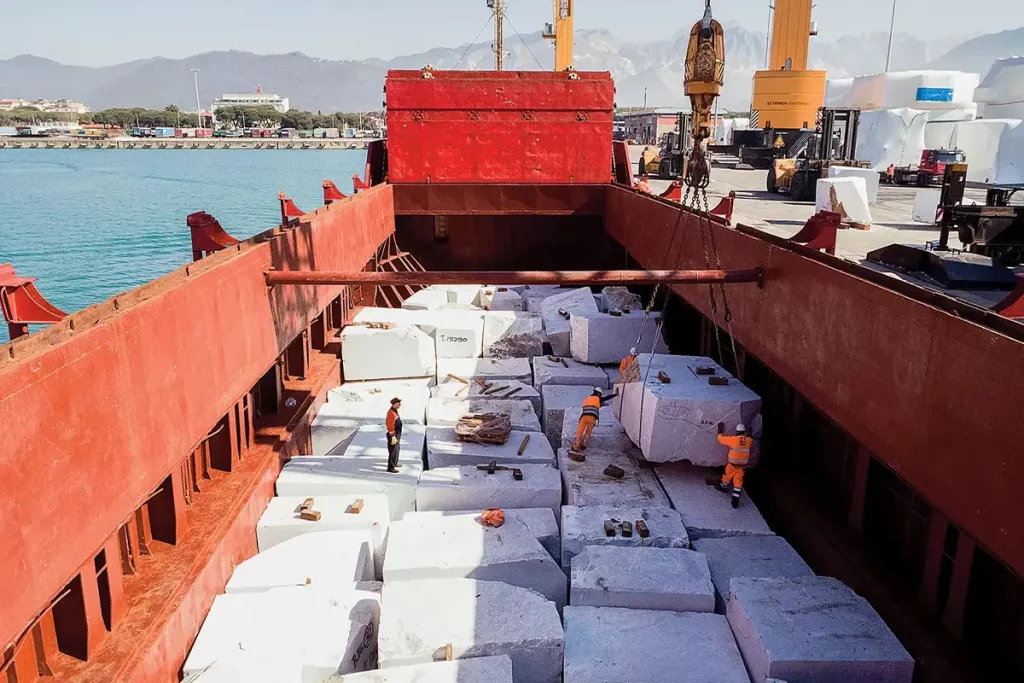The Renaissance artist Michaelangelo could free an image from a marble block, as he used to say. Italian start-up Fili Pari has turned a material such as marble into a sustainable textile for the industry
Milan startup Fili Pari MARM\MORE®: a waterproof and windproof fabric made from stone processing waste
Michelangelo Buonarroti used to say «When you see a marble block, think of the image: the image is inside; you just need to strip it away». Italian start-up Fili Pari has transformed a material such as Italian marble into sustainable textile fiber.
MARM\MORE® is the name, a technical fabric obtained by spreading marble powder onto an existing textile and turning it into a waterproof, breathable, windproof and abrasion-resistant material.
The term originates from Marmor, the Latin translation of marble, to signify the close connection between the material and the Italian territory. The suffix more that follows indicates how marble adds value to the material, providing an additional dimension compared to the classic polyurethane coatings. More also signifies a different perception of marble itself: the visualization of a heavy-duty and static material into something light and wearable.
Fili Pari and the valorization of Italian marble powders – Italian creativity and respect for the territory
The start-up Fili Pari combines research, Italian creativity and respect for the territory.
The two founders Alice Zantedeschi and Francesca Pievani, with the help of the Polihub business accelerator of the Polytechnic of Milan, started in 2017 a path led to the birth of the company three years later with the name Fili Pari. The name was chosen because it represents the anagram of their birth names, but also recalls the symbol of a thread that is the emblem of the fashion industry.
With Fili Pari’s technology, Italian marble dust, a byproduct of quarries, is transformed into a microfilm that imparts technical performance to fabrics, bridging the gap between two materials that seem worlds apart, marble and fabrics.
Fili Pari MARM\MORE®: The composition and manufacturing process of the material from Italian marble powder
For the initial prototype of MARM\MORE®, Zantedeschi and Pievani used less than ten percent of marble powder, whilst the newer formulation counts up to 50 percent with various types of marble added to the mixture.
When analyzing the textile industry, Italian marble had never been used except for its aesthetic inspiration.
However, in its scientific formulation, as calcium carbonate, it is used in many fields other than construction: chemistry, pharmaceuticals, and even agri-food as a supplement. From there, Fili Pari developed their first patent.
Fili Pari’s MARM\MORE® works like a coating on fabric. It functions like faux leather, but since it uses up to 50 percent marble powder, it replaces a portion of the synthetic component. It is basically a wearable microfilm containing real marble dust, which can be coupled with any type of fabric and used as the outer layer of clothing.
A zero-waste approach: sustainable textile manufacturing the technical material MARM\MORE®
The result works like a membrane that is waterproof, breathable, windproof, and abrasion-resistant. It is lightweight weighing only 200 grams, with soft texture, avoiding the typical rubbery feel of synthetic fabrics.
When it comes to sustainable textile manufacturing, to stay true to a zero-waste approach, the technical material MARM\MORE® is used in combination with soft wools, surplus stocks from high-quality fashion companies, recovered cotton, or recycled materials like certified nylon.
The material’s versatility is a strength: by adjusting the composition and structure of this blend, Fili Pari has adapted it to the fashion industry with their own clothing collection, as well as other sectors, such as automotive and interior applications.
Fili Pari’s Italian marble production: when sustainable practices integrate networking and collaboration with local production sites
Innovation and sustainability can be a winning combination if one is capable of networking and integrating with local realities. Italy, not surprisingly, holds the European record for recycling with a rate of 83.4 percent, far surpassing the European average of 53.4 percent.
However, when you want to pursue a path of sustainability, it must be a systematic journey that connects different production sites sharing and seeking the same goals.
Fili Pari has made collaboration with the local community a distinctive feature, along with a high technological coefficient. The creation of a new type of yarn from the waste of a material like marble is possible thanks to the collaboration with local businesses: on one side, there’s marble, which plays a key role in Italy’s artistic history; on the other, fashion, another fundamental sector for the ‘Made in Italy’ brand.
Fili Pari doesn’t focus on artisanal productions, but rather scalable industrial production – sustainability, innovation, and is connected to the local community and a raw material
Fili Pari doesn’t focus on artisanal productions, but rather scalable industrial production. To set it up, they need to rely on facilities with scaling capabilities, which is where the relationship with local businesses comes into play.
This also enhances an aspect surrounding sustainability that isn’t just about using the right materials but mostly about valorizing resources and the productive realities from which they are acquired from. Consequently, turning local artisans into players in the business means providing jobs and promoting Italian excellence.
Being a startup, they outsource a lot. Virtually the entire supply chain and products are produced externally. This is because they want to maintain a lean structure and also because they currently don’t have machinery. To create different materials, you need to use completely different machines: that is why it wouldn’t make sense for a startup like theirs to internalize processes that are so diverse because it would be too costly.
Unintentionally, Zentedeschi and Pievani embody the current trends: we are a company founded by women that focuses on sustainability, innovation, and is connected to the local community and a raw material so close to heart like marble is for Italians. This aspect evokes a range of emotional and sentimental meanings for people.
A short supply chain of Italian marbles – Reinforcing the Made in Italy brand: Verona, Bergamo, Carrara and the Aosta Valley
Fili Pari operates in a localized area in Italy, and directly supplies marble dust to various textile partner companies.
Unlike large chains, which may need to track numerous movements of the products, their materials typically travel within a 300 kilometers radius at most. The farthest point where they source marble is currently in Tuscany, and the processing is entirely done in Lombardy.
The materials’ choice focuses on Italian marbles found in specific stone districts: in Orsara, Verona, the quarry where on one side the Rosso Verona marble is extracted and on the other the waste resulting from the processing cut is reintroduced into the mountains, and Bergamo – where there is a quarry of ebony black marble. Most recently, they added Carrara among the partners they are collaborating with.
Inside their catalog of marbles they also have the yellow one from the Trentino area, and the green one from the Aosta Valley.
The entire production cycle, involving those who extract and process the raw material, also addresses the need to find alternative solutions to the disposal issues that these actors encounter when dealing with marble byproducts, characterized by high costs and complexity.
Fili Pari: Byproducts of processed stone and marbles used as raw material in the sustainable textile industry in a Circular Economy perspective
In Fili Pari’s manifesto, they mention Circular Economy and the value in the value of which the Made in Italy is imbued. They apply this concept to their work both upstream and downstream in the supply chain.
Regarding the material, they use both production marbles and marbles resulting from processing. When stone is processed, a byproduct of processing cataloged as waste is typically generated, and in order to dispose of it they must be treated as special waste.
Fili Pari and the desire for traceable value chains – behind blockchain-based traceability
One of the most common claims lately, even among larger companies, is the desire for traceable value chains. At the moment, Fili Pari doesn’t have blockchain-based traceability because they don’t possess the complexity that would make it necessary.
This was the case for their material production: they leveraged existing business tools and provided the right guidance to adapt their processes to the product. Regarding the garments, they are entrusted to manufacturing companies or seamstresses, depending on the batch. The weaving professionals, with manual skills passed down through generations, can work with new fabrics that may require different adjustments from what they are used to handling.
Including an atypical material in the sustainable textile industry – the idea can be disruptive, but the material production needs to be feasible
The fashion industry is often considered oversaturated. Sometimes, finding an investor willing to believe in another new company in the industry is hard. Fili Pari is a fashion-tech company, hence it classifies differently from the traditional fashion businesses.
In Zantedeschi and Pievani’s words, investors are interested in the assets the startup can bring to the industry. The innovative aspects of this project lie in the final garment and the patents that underlie it.
Fili Pari form marble dust to raw materials
Fili Pari is an Italian start-up founded in Milan in 2020. They are the first to have introduced marble dust as a raw material for the sustainable textile industry with the introduction of MARM\MORE®




















